The global file sander market, valued at USD 847.5 million in 2025 and forecast to reach USD 1,195.5 million by 2035, reflects a CAGR of 3.5% and an absolute increase of USD 348.0 million. Year-over-year analysis shows a steady yet segmented growth trajectory, with the decade divided into an early stage of cordless adoption and a later stage of technological integration and mass penetration. The file sander market will expand by nearly 1.4X, supported by continuous improvements in sanding efficiency, dust management, and compatibility with broader power tool systems across residential, industrial, and commercial domains.
From 2025 to 2026, incremental growth will be modest as adoption is largely concentrated in early DIY and professional segments. By 2027, stronger year-over-year increases emerge as cordless platforms achieve wider recognition, with performance improvements and longer battery runtimes driving purchasing decisions. Between 2028 and 2029, annual growth gains momentum, reflecting broader acceptance in construction sites and furniture manufacturing. By 2030, the file sander market is expected to reach USD 973.8 million, capturing 36% of total expansion. The year-over-year trend in this first phase demonstrates consistent but moderate increments, tied closely to demand for mobility, variable speed control, and dust-free precision sanding solutions.
Between 2030 and 2032, the pace of growth intensifies as brushless motor systems and digitally integrated sanders enter mainstream use. Year-over-year revenue increases during this interval are larger compared to the earlier half, supported by the shift from entry-level adoption to professional-grade replacement cycles. By 2033, mass deployment in automated workshops and industrial finishing processes further boosts annual increments, with sanding systems increasingly marketed as essential components of integrated tool ecosystems.
By 2034 and 2035, the file sander market consolidates at USD 1,195.5 million, adding USD 221.7 million in the latter half of the decade, or 64% of total gains. Year-over-year analysis during these years shows consistent growth sustained by replacement demand, upgraded workshop automation, and expanding adoption in emerging economies where woodworking and small-scale manufacturing are on the rise.
The decade-long year-over-year pattern highlights early incremental growth tied to cordless innovations, followed by a stronger second half supported by professional adoption, automation compatibility, and brushless motor penetration. Peaks in growth correspond with product innovation cycles, while troughs remain shallow, showing that demand is durable and resistant to market volatility.
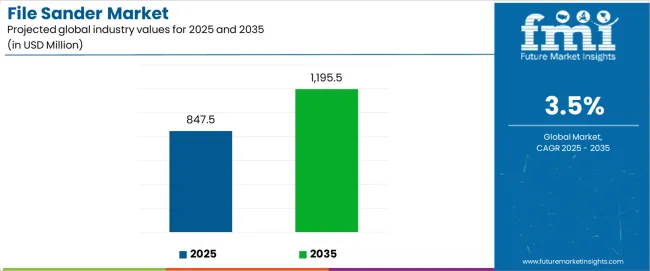
The file sander market demonstrates distinct growth phases with varying market characteristics and competitive dynamics. Between 2025 and 2030, the file sander market progresses through its cordless technology adoption phase, expanding from USD 847.5 million to USD 973.8 million with steady annual increments averaging 3.7% growth. This period showcases the transition from basic corded units to advanced battery-powered systems with integrated dust management and ergonomic design becoming mainstream features.
The 2025-2030 phase adds USD 126.3 million to market value, representing 36% of total decade expansion. Market maturation factors include standardization of battery platforms, declining costs for lithium-ion technology, and increasing professional awareness of cordless benefits reaching 85-90% effectiveness in precision sanding applications. Competitive landscape evolution during this period features established manufacturers like Milwaukee and DeWalt expanding their cordless portfolios while new entrants focus on specialized ergonomic solutions and enhanced dust extraction technology.
From 2030 to 2035, market dynamics shift toward advanced automation and multi-application deployment, with growth accelerating from USD 973.8 million to USD 1,195.5 million, adding USD 221.7 million or 64% of total expansion. This phase transition logic centers on universal brushless motor systems, integration with smart workshop equipment, and deployment across diverse professional scenarios, becoming standard rather than specialized power tool formats. The competitive environment matures with focus shifting from basic functionality to comprehensive performance optimization and compatibility with modern workshop automation systems.
| Metric | Value |
|---|---|
| Market Value (2025) | USD 847.5 million |
| Market Forecast (2035) | USD 1,195.5 million |
| Growth Rate | 3.50% CAGR |
| Leading Type | Cordless |
| Primary Sales Channel | Offline Sales Segment |
The file sander market demonstrates strong fundamentals with cordless systems capturing a dominant 67% share through superior mobility characteristics and advanced battery capabilities. Offline sales drive primary distribution, supported by increasing professional preference for hands-on product evaluation and dealer support requirements. Geographic expansion remains concentrated in developed markets with established power tool infrastructure, while emerging economies show accelerating adoption rates driven by construction activity and rising professional tool awareness.
The file sander market represents a compelling intersection of power tool innovation, precision woodworking advancement, and workshop optimization management. With robust growth projected from USD 847.5 million in 2025 to USD 1,195.5 million by 2035 at a 3.50% CAGR, this market is driven by increasing construction activity trends, professional workshop requirements, and DIY demand for precision sanding formats.
The file sander market's expansion reflects a fundamental shift in how professionals and hobbyists approach precision woodworking infrastructure. Strong growth opportunities exist across diverse applications, from residential projects requiring detailed finish work to industrial facilities demanding heavy-duty solutions. Geographic expansion is particularly pronounced in Asia-Pacific markets, led by China (4.7% CAGR) and India (4.4% CAGR), while established markets in North America and Europe drive innovation and specialized segment development.
The dominance of cordless systems and offline sales underscores the importance of proven battery technology and hands-on product evaluation in driving adoption. Battery life and charging complexity remain key challenges, creating opportunities for companies that can deliver consistent performance while maintaining operational efficiency.
Market expansion rests on three fundamental shifts driving adoption across professional and consumer sectors. Construction industry growth creates compelling advantages through file sander systems that provide comprehensive precision finishing with portable operation compatibility, enabling contractors to achieve professional results and maintain project schedules while ensuring consistent finish quality and justifying investment over basic manual sanding methods. Professional workshop modernization accelerates as craftspeople worldwide seek reliable precision tools that deliver operational efficiency directly to detailed finishing operations, enabling quality improvement that aligns with professional standards and maximizes productivity. DIY market expansion drives adoption from residential consumers requiring accessible precision tools that maximize finishing capabilities while maintaining user-friendly operation during home improvement and crafting projects.
The growth faces headwinds from battery technology costs that differ across manufacturers regarding price stability and performance consistency, potentially limiting adoption rates in price-sensitive consumer categories. Competition from alternative finishing methods also persists regarding multi-tool systems and manual techniques that may provide adequate results in applications with less demanding precision requirements.
Primary Classification: The market segments by type into corded and cordless categories, representing the evolution from basic plug-in units to advanced battery-powered formats for comprehensive mobility operations.
Secondary Breakdown: Sales channel segmentation divides the file sander market into online and offline sales, reflecting distinct purchasing preferences for hands-on evaluation versus convenience shopping.
Regional Classification: Geographic distribution covers North America, Europe, Asia Pacific, Latin America, and the Middle East & Africa, with developed markets leading innovation while emerging economies show accelerating growth patterns driven by construction development programs.
The segmentation structure reveals technology progression from standard corded units toward integrated battery-powered platforms with enhanced mobility and performance capabilities, while sales channel diversity spans from traditional retail operations to e-commerce platforms requiring comprehensive product demonstration and technical support solutions.
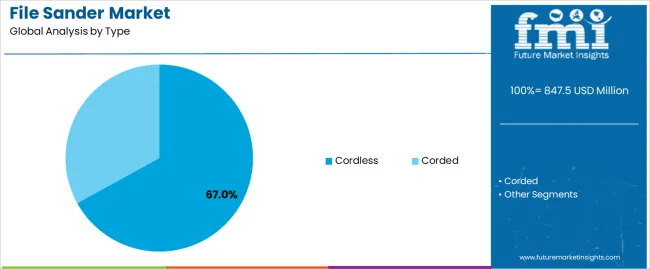
Cordless segment is estimated to account for 67% of the file sander market share in 2025. The segment's leading position stems from its fundamental role as a critical component in mobile precision applications and its extensive use across multiple professional and residential sectors. Cordless technology's dominance is attributed to its superior mobility characteristics, including excellent battery life, reliable power delivery, and balanced weight distribution that make it indispensable for precision finishing operations.
Market Position: Cordless systems command the leading position in the file sander market through advanced lithium-ion technologies, including comprehensive battery management, consistent power output, and reliable charging performance that enable users to deploy precision tools across diverse working environments.
Value Drivers: The segment benefits from professional preference for mobile tool profiles that provide exceptional flexibility without requiring power cord management. Efficient battery systems enable deployment in workshop operations, job sites, and residential applications where mobility and convenience represent critical selection requirements.
Competitive Advantages: Cordless systems differentiate through excellent runtime performance, proven power consistency, and compatibility with existing battery platforms that enhance tool utility while maintaining economical ownership profiles suitable for diverse precision applications.
Key market characteristics:
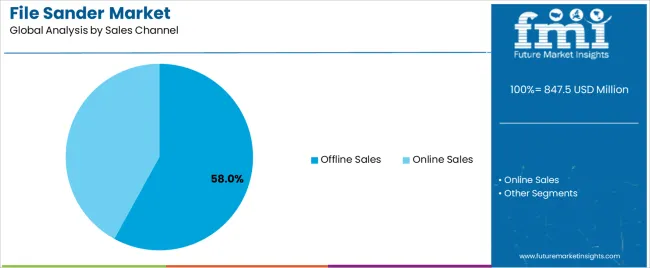
Offline sales segment is projected to hold 58% of the file sander market share in 2025. The segment's market leadership is driven by the extensive preference for hands-on product evaluation in power tool purchasing, professional dealer support, and immediate product availability, where traditional retail serves as both a demonstration platform and service solution. The offline sector's consistent dominance supports the segment's leading position.
Market Context: Offline sales dominate the file sander market due to widespread preference for physical product testing and increasing focus on professional consultation, technical support, and warranty service that enhance purchasing confidence while maintaining dealer relationships.
Appeal Factors: Professional buyers prioritize hands-on evaluation, expert recommendations, and integration with existing tool ecosystems that enable coordinated purchasing across multiple precision needs. The segment benefits from substantial dealer networks and service infrastructure that emphasize reliable support systems for professional power tool applications.
Growth Drivers: Tool distributor expansion incorporates file sanders as standard components for professional workshop and construction programs. At the same time, dealer service initiatives are increasing demand for premium support that complies with professional standards and enhances user satisfaction.
Market Challenges: Online competition and direct-to-consumer trends may limit traditional retail flexibility in price-sensitive markets or regions with developing dealer networks.
Sales dynamics include:
Growth Accelerators: Construction activity expansion drives primary adoption as file sander systems provide exceptional precision capabilities that enable professional finishing without material waste, supporting quality improvement and project efficiency that require reliable power tool formats. DIY market growth accelerates market expansion as homeowners seek accessible precision tools that maintain professional results during home improvement while enhancing project capabilities through standardized operation and user-friendly controls. Professional awareness increases worldwide, creating sustained demand for mobile precision systems that complement workshop routines and provide operational advantages in finishing efficiency.
Growth Inhibitors: Battery cost volatility challenges differ across power tool markets regarding price stability and technology consistency, which may limit adoption predictability and investment planning in price-sensitive consumer categories with demanding affordability requirements. Competition complexity persists regarding multi-tool alternatives and manual finishing methods that may provide adequate results in applications with less demanding precision protocols. Market fragmentation across multiple battery platforms and compatibility standards creates ecosystem concerns between different tool brands and existing workshop infrastructure.
Market Evolution Patterns: Adoption accelerates in professional and residential sectors where mobility benefits justify technology investments, with geographic concentration in developed markets transitioning toward mainstream adoption in emerging economies driven by construction and manufacturing development. Technology advancement focuses on enhanced battery performance, improved motor efficiency, and integration with smart tool systems that optimize precision capabilities and operational consistency. The file sander market could face disruption if alternative finishing technologies or battery standardization significantly challenge traditional file sander advantages in precision applications.
The file sander market demonstrates varied regional dynamics with growth leaders including China (4.7% CAGR) and India (4.4% CAGR) driving expansion through construction growth and manufacturing modernization. Steady Performers encompass Germany (4.0% CAGR), Brazil (3.7% CAGR), USA (3.3% CAGR), UK (3.0% CAGR), and Japan (2.6% CAGR), benefiting from established tool markets and professional adoption.
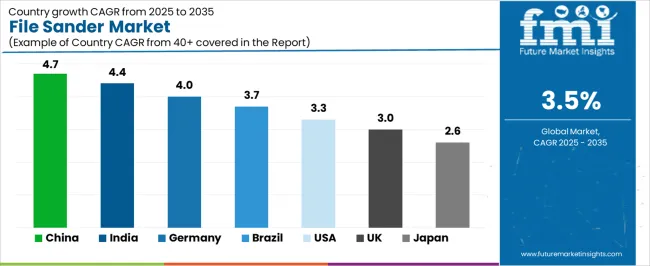
| Country | CAGR (2025-2035) |
|---|---|
| China | 4.7% |
| India | 4.4% |
| Germany | 4.0% |
| Brazil | 3.7% |
| USA | 3.3% |
| UK | 3.0% |
| Japan | 2.6% |
Regional synthesis reveals Asia-Pacific markets leading growth through manufacturing expansion and construction development, while European countries maintain steady expansion supported by professional workshop upgrades and precision crafting requirements. North American markets show moderate growth driven by DIY demand and professional contractor adoption.
China establishes regional leadership through rapid industrial development and comprehensive manufacturing modernization, integrating advanced file sander systems as standard components in furniture production and precision manufacturing operations. The country's 4.7% CAGR through 2035 reflects manufacturing expansion promoting industrial density and production infrastructure development that mandate the use of reliable precision tools in woodworking operations. Growth concentrates in major manufacturing regions, including Guangdong, Jiangsu, and Zhejiang, where production facilities showcase integrated file sander systems that appeal to manufacturers seeking enhanced finishing efficiency and international quality standards.
Chinese manufacturers are developing innovative file sander solutions that combine local production advantages with international performance specifications, including brushless motor systems and advanced dust collection capabilities.
Strategic Market Indicators:
The Indian market emphasizes construction applications, including rapid urban development and comprehensive infrastructure expansion that increasingly incorporates file sanders for finishing work and precision carpentry applications. The country is projected to show a 4.4% CAGR through 2035, driven by massive construction activity under smart city initiatives and residential demand for quality finishing systems. Indian construction facilities prioritize cost-effectiveness with file sanders delivering operational efficiency through economical tool usage and reliable performance capabilities.
Technology deployment channels include major construction companies, carpentry workshops, and furniture manufacturers that support high-volume usage for domestic and commercial applications.
Performance Metrics:
The German market emphasizes advanced file sander features, including innovative motor technologies and integration with comprehensive workshop platforms that manage precision finishing, dust collection, and quality control applications through unified tool systems. The country is projected to show a 4.0% CAGR through 2035, driven by professional workshop expansion under Industry 4.0 initiatives and manufacturing demand for premium, reliable precision systems. German craftspeople prioritize quality with file sanders delivering comprehensive finishing capabilities through enhanced precision control and operational innovation.
Technology deployment channels include major tool retailers, professional workshops, and manufacturing facilities that support custom development for premium operations.
Performance Metrics:
In São Paulo, Rio de Janeiro, and Belo Horizonte, Brazilian construction companies and furniture manufacturers are implementing file sander systems to enhance finishing capabilities and support operational efficiency that aligns with quality protocols and production standards. The Brazilian market demonstrates sustained growth with a 3.7% CAGR through 2035, driven by construction development programs and manufacturing investments that emphasize reliable precision tools for residential and commercial applications. Brazilian facilities are prioritizing file sander systems that provide exceptional finishing quality while maintaining compatibility with local production standards and minimizing operational complexity, particularly important in furniture manufacturing and construction finishing operations.
Market expansion benefits from infrastructure development programs that mandate enhanced precision in finishing specifications, creating sustained demand across Brazil's manufacturing and construction sectors, where quality consistency and productivity represent critical requirements.
Strategic Market Indicators:
The USA market emphasizes consumer accessibility and professional capability, growing at 3.3% CAGR, with documented operational excellence in DIY applications and professional workshops through integration with existing tool ecosystems and quality assurance infrastructure. The country leverages engineering expertise in cordless technology and motor design to maintain market innovation. Major markets, including California, Texas, and Florida, showcase advanced adoption where file sander systems integrate with comprehensive workshop platforms and home improvement systems to optimize finishing capabilities and operational efficiency.
American consumers and professionals prioritize tool versatility and battery compatibility in product selection, creating demand for premium file sander systems with advanced features, including variable speed control and integration with existing power tool platforms. The file sander market benefits from established retail infrastructure and willingness to invest in specialized cordless technologies that provide superior mobility and regulatory compliance.
Market Intelligence Brief:
The UK market demonstrates comprehensive quality emphasis, growing at 3.0% CAGR, with established professional workshops and DIY enthusiasts prioritizing reliable precision tools that complement traditional craftsmanship while meeting modern efficiency requirements. British professionals focus on tool durability and consistent performance in product evaluation, supported by comprehensive dealer networks and service infrastructure throughout England, Scotland, and Wales.
Market development benefits from strong woodworking traditions and professional training programs that emphasize quality finishing techniques, creating sustained demand for file sanders that provide precision control and operational reliability in both commercial workshops and home improvement applications.
Performance Metrics:
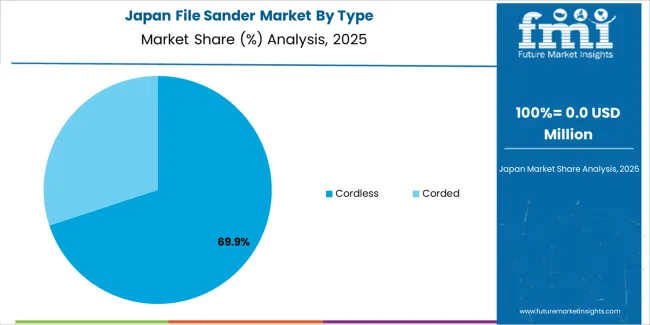
Japan's sophisticated power tool market demonstrates meticulous file sander deployment, growing at 2.6% CAGR, with documented operational excellence in precision manufacturing and professional woodworking through integration with existing quality control systems and craftsmanship infrastructure. The country leverages engineering expertise in motor technology and precision manufacturing to maintain market leadership. Industrial centers, including Tokyo, Osaka, and Nagoya, showcase advanced installations where file sander systems integrate with comprehensive workshop platforms and quality systems to optimize precision finishing and operational efficiency.
Japanese professionals prioritize precision consistency and build quality in tool selection, creating demand for premium file sander systems with advanced features, including micro-speed adjustment and integration with automated workshop protocols. The file sander market benefits from established manufacturing infrastructure and willingness to invest in specialized precision technologies that provide superior accuracy and regulatory compliance.
Market Intelligence Brief:
The file sander market in Europe is projected to grow from USD 182.4 million in 2025 to USD 254.7 million by 2035, registering a CAGR of 3.4% over the forecast period. Germany is expected to maintain its leadership position with a 38.2% market share in 2025, declining slightly to 37.8% by 2035, supported by its manufacturing excellence and major industrial centers, including Bavaria and Baden-Württemberg.
United Kingdom follows with a 26.1% share in 2025, projected to reach 26.5% by 2035, driven by comprehensive professional workshop programs and DIY market initiatives. France holds a 19.4% share in 2025, expected to maintain 19.7% by 2035 through established craftsmanship sectors and construction adoption. Italy commands a 10.8% share, while Spain accounts for 4.2% in 2025. The Rest of Europe region is anticipated to gain momentum, expanding its collective share from 1.3% to 1.9% by 2035, attributed to increasing construction development in Eastern European countries and emerging professional workshop programs implementing precision tool systems.
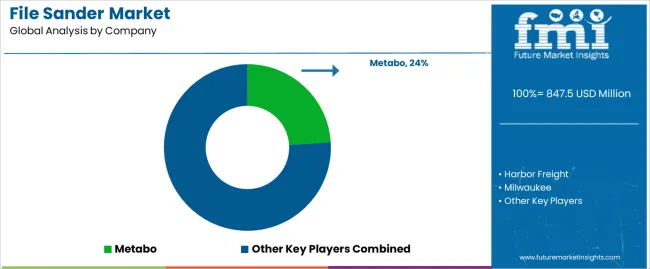
The file sander market operates with moderate concentration, featuring approximately 15-20 participants, where leading companies control roughly 45-52% of the global market share through established distribution networks and comprehensive battery platform capabilities. Competition emphasizes motor performance, battery compatibility, and operational efficiency rather than premium feature rivalry.
Market leaders encompass Metabo, Harbor Freight, and Milwaukee, which maintain competitive advantages through extensive cordless technology expertise, global distribution networks, and comprehensive technical support capabilities that create dealer loyalty and support professional requirements. These companies leverage decades of power tool experience and ongoing battery technology investments to develop advanced file sander systems with exceptional precision and mobility features.
Specialty challengers include DeWalt, Hilti, and Einhell, which compete through specialized application innovation focus and efficient manufacturing solutions that appeal to professional buyers seeking reliable performance formats and battery ecosystem compatibility. These companies differentiate through operational efficiency emphasis and specialized market focus.
Market dynamics favor participants that combine consistent motor performance with advanced battery support, including fast charging and platform compatibility capabilities. Competitive pressure intensifies as traditional power tool manufacturers expand into specialized sanding systems. At the same time, emerging cordless specialists challenge established players through innovative battery formulations and cost-effective production targeting emerging professional segments.
| Item | Value |
|---|---|
| Quantitative Units | USD 847.5 million |
| Type | Corded, Cordless |
| Sales Channel | Online Sales, Offline Sales |
| Application | Professional, DIY, Industrial, Construction, Woodworking, Others |
| Regions Covered | North America, Europe, Asia Pacific, Latin America, Middle East & Africa |
| Countries Covered | China, India, Germany, Brazil, USA, UK, Japan, and 25+ additional countries |
| Key Companies Profiled | Metabo, Harbor Freight, Milwaukee, DeWalt, Hilti, Einhell |
| Additional Attributes | Dollar sales by type and sales channel categories, regional adoption trends across Asia Pacific, Europe, and North America, competitive landscape with power tool manufacturers and cordless specialists, consumer preferences for mobility characteristics and battery performance, integration with workshop equipment and tool ecosystems, innovations in brushless motor technology and battery platforms, and development of specialized precision solutions with enhanced dust collection and variable speed features |
The global file sander market is estimated to be valued at USD 847.5 million in 2025.
The market size for the file sander market is projected to reach USD 1,195.5 million by 2035.
The file sander market is expected to grow at a 3.5% CAGR between 2025 and 2035.
The key product types in file sander market are cordless and corded.
In terms of sales channel, offline sales segment to command 58.0% share in the file sander market in 2025.






Full Research Suite comprises of:
Market outlook & trends analysis
Interviews & case studies
Strategic recommendations
Vendor profiles & capabilities analysis
5-year forecasts
8 regions and 60+ country-level data splits
Market segment data splits
12 months of continuous data updates
DELIVERED AS:
PDF EXCEL ONLINE
Band File Sander Belts Market Size and Share Forecast Outlook 2025 to 2035
File Integrity Monitoring Market Size and Share Forecast Outlook 2025 to 2035
Profiled Steel Sheet Decking Market Size and Share Forecast Outlook 2025 to 2035
Low Profile Compact System Closures Market Size and Share Forecast Outlook 2025 to 2035
Road Profile Laser Sensor Market Size and Share Forecast Outlook 2025 to 2035
Managed File Transfer (MFT) Market Size and Share Forecast Outlook 2025 to 2035
Network File System Market Size and Share Forecast Outlook 2025 to 2035
Enterprise File Sync And Share Platform Market Size and Share Forecast Outlook 2025 to 2035
Enterprise File Sharing And Synchronization Market
Aluminium Profiles for Solar Panel Market Size and Share Forecast Outlook 2025 to 2035
Brushless Cordless Band Files Market Size and Share Forecast Outlook 2025 to 2035
Electronic Trial Master File (eTMF) System Market Size and Share Forecast Outlook 2025 to 2035
Sander Market
Angle Sander Market Size and Share Forecast Outlook 2025 to 2035
Cordless Sanders Market Analysis Size and Share Forecast Outlook 2025 to 2035

Thank you!
You will receive an email from our Business Development Manager. Please be sure to check your SPAM/JUNK folder too.
Chat With
MaRIA